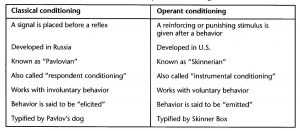Classical Conditioning vs Operant Conditioning: Dog Training
The operant conditioning technique
This technique involves reinforcement, or punishment, for your dog upon completion of a behavior, a lot like you might train your children.
It’s voluntary, your dog is an active participant in this process whether the behavior is positive or negative. Rather than rewarding your dog every single time it displays the correct behavior, evidence actually suggests it is far more effective to do so at random to ensure that he will always behave that way. We don’t generally think about our dogs in terms of science and psychology, but actually that is exactly what dog training is – scientific and psychological studies have been carried out and highly support operant conditioning training (http://blogs.scientificamerican.com/thoughtful-animal/what-is-operant-conditioning-and-how-does-it-explain-driving-dogs/). A lot of the dog trainers you see on television use the operant conditioning technique, and so do zoo keepers and animal handlers. While B.F. Skinner gets the credit for it, he merely expanded on it and popularized it- it was first mentioned by Edward L. Thorndike in the early 1900’s.
The classical conditioning technique
This is probably most associated with Ivan Pavlov’s dog experiment. It’s involuntary behavior, an automatic response. This limits the scope of the classical conditioning technique because it is simply an instinctive response, it’s the basics, but don’t let that put you off. There is value in these techniques just as much as there is in the operant technique (http://www.blongs.scientificamerican.com/thoughtful-animal/what-is-classical-conditioning-and-why-does-it-matter/). http://www.scientificamerican/com/extinction-countdown/lions-vs-cattle-taste-aversion/). Because the idea behind classical conditioning is simply creating an association between two stimuli to garner the desired response it can be adopted and adapted in creative ways. For instance, there is a wildlife conservation that was employing the technique in an effort to prevent the lions from preying on all of the cattle (http://www.scientificamerican/com/extinction-countdown/lions-vs-cattle-taste-aversion/). When you open a packet of dog treats and give one to your dog it will know from then on that that sound means a treat, but the sound can also be created by any packet of food. So, there’s a pretty good chance that when you open a bag of chips, or cookies, your dog’s ears will be quick to perk up at the sound. Your dog takes regular trips to the vet, and he gets there by car in his dog carrier or crate so whenever you get that crate out there’s a good chance your dog might respond poorly as that carrier, regardless of what you have it out for, might mean a trip to the vet. Your dog loves to go for walks and you keep its leash in the hall cupboard, so every time you go to the hall cupboard for your jacket, or to put the vacuum away your dog bounces from wherever he was hiding, excited at the prospect of going for walks. These are natural responses from your dog based on the everyday classical conditioning he is exposed to.
-Nick White
Founder/Owner
Off Leash K9 Training
www.offleashk9training.com
[email protected]

